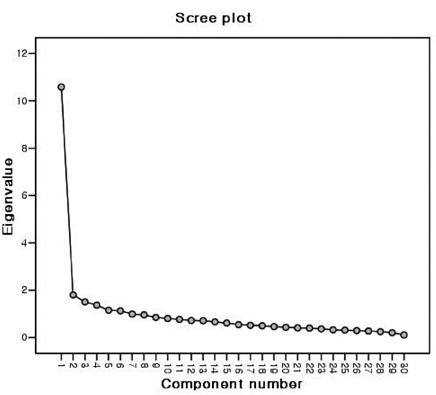Yonsei Med J.
2008 Oct;49(5):698-704. 10.3349/ymj.2008.49.5.698.
The Behcet't Disease Quality of Life: Reliability and Validity of the Korean Version
- Affiliations
-
- 1Department of Dermatology and Psychiatry, Ajou University School of Medicine, Suwon, Korea. esl@ajou.ac.kr
- 2Department of of Psychiatry, Samsung Medical Center, Sungkyunkwan University School of Medicine, Seoul, Korea.
- 3Department of Psychiatry, Ajou University School of Medicine, Suwon, Korea.
- 4Department of Dermatology, Yonsei University College of Medicine, Seoul, Korea.
- 5Department of Dermatology, Gachon University of Medicine and Science, Incheon, Korea.
- KMID: 2158186
- DOI: http://doi.org/10.3349/ymj.2008.49.5.698
Abstract
-
PURPOSE: The Behcet's Disease Quality of Life (BD-QoL) is a BD-specific measure developed in the UK. The aim of this study was to adapt the BD-QoL for use in Korea.
PATIENTS AND METHODS
The translation was based on the guidelines for cross-cultural adaptation. A total of 201 Korean patients with BD participated in this study. To evaluate the psychometric properties, internal consistency and test-retest reliability were used. Factor analysis was performed to examine the construct validity. To provide further evidence for validity, the correlation of BD-QoL with the Clinical Activity Form for Korean Patients with BD (BDCAF-K) and the Center for Epidemiologic Studies-Depression (CES-D) scales was assessed.
RESULTS
The Korean version had high internal consistency (Cronbach's alpha, 0.93) and test-retest reliability (r = 0.835). Factor analysis of the questionnaire revealed one interpretable factor as a general health-related quality of life factor. The Korean version significantly correlated with scores of CES-D (r = 0.749, p = 0.000), self-rating scale of well-being over the past 28 days (r = 0.446, p = 0.000), and BDCAF-K score (r = 0.502, p = 0.000).
CONCLUSION
Adaptation of the BD-QoL for use in Korea was successful. Together with the BDCAF-K, it may be a valuable tool for assessing the influence of interventions in BD patients and outcome in clinical trials.
Keyword
MeSH Terms
Figure
Cited by 1 articles
-
Behçet's Disease Current Activity Form as a Patient's Derived Measure
Hyo Jin Choi, Mi Ryoung Seo, Hee Jung Ryu, Han Joo Baek
J Rheum Dis. 2016;23(1):19-22. doi: 10.4078/jrd.2016.23.1.19.
Reference
-
1. Suzuki Kurokawa M, Suzuki N. Behçet's disease. Clin Exp Med. 2004. 4:10–20.2. Alpsoy E, Zouboulis CC, Ehrlich GE. Mucocutaneous lesions of Behçet's disease. Yonsei Med J. 2007. 48:573–585.
Article3. Gilworth G, Chamberlain MA, Bhakta B, Haskard D, Silman A, Tennant A. Development of the BD-QoL: a quality of life measure specificto Behçet's disease. J Rheumatol. 2004. 31:931–937.4. Bhakta BB, Brennan P, James TE, Chamberlain MA, Noble BA, Silman AJ. Behçet's disease: evaluation of a new instrument to measure clinical activity. Rheumatology (Oxford). 1999. 38:728–733.5. Emery P, Kosinski M, Li T, Martin M, Williams GR, Becker JC, et al. Treatment of rheumatoid arthritis patients with abatacept and methotrexate significantly improved health-related quality of life. J Rheumatol. 2006. 33:681–689.6. Blackford S, Finlay AY, Roberts DL. Quality of life in Behçet's syndrome: 335 patients surveyed. Br J Dermatol. 1997. 136:293.7. Bodur H, Borman P, Özdemir Y, Atan Ç, Kural G. Quality of life and life satisfaction in patients with Behçet's disease: relationship with disease activity. Clin Rheumatol. 2006. 25:329–333.
Article8. Gur A, Sarac AJ, Burkan YK, Nas K, Cevik R. Arthropathy, quality of life, depression, and anxiety in Behçet's disease: relationship between arthritis and these factors. Clin Rheumatol. 2006. 25:524–531.
Article9. International Study Group for Behçet's Disease (ISGBD). Criteria for diagnosis of Behçet's disease. Lancet. 1990. 335:1078–1080.10. Beaton DE, Bombardier C, Guillemin F, Ferraz MB. Guidelines for the process of cross-cultural adaptation of self-report measures. Spine. 2000. 25:3186–3191.
Article11. Lee ES, Kim HS, Bang D, Yu HG, Chung H, Shin DH, et al. Development of clinical activity form for Korean patients with Behçet's disease. Adv Exp Med Biol. 2003. 528:153–156.
Article12. Cho MJ, Kim KH. Use of the Center for Epidemiologic Studies Depression (CES-D) Scale in Korea. J Nerv Ment Dis. 1998. 186:304–310.13. Hubley AM, Russell LB, Palepu A. Injection Drug Use Quality of Life Scale (IDUQOL): a validation study. Health Qual Life Outcomes. 2005. 3:43.14. DeVellis RF. DeVellis RF, editor. Factor analysis. Scale development: Theory and applications (applied Social Research Methods). 2003. 2nd ed. Thousand Oaks: Sage Publications;102–137.15. Russell DW. In search of underlying dimensions: The use (and abuse) of factor analysis in personality and social psychology bulletin. Pers Soc Psychol Bull. 2002. 28:1629–1646.
Article16. Weissman MM, Bland R, Joyce PR, Newman S, Wells JE, Wittchen HU. Sex differences in rates of depression: cross-national perspectives. J Affect Disord. 1993. 29:77–84.17. Mumcu G, Inanc N, Ergun T, Ikiz K, Gunes M, Islek U, et al. Oral health related quality of life is affected by disease activity in Behçet's disease. Oral Dis. 2006. 12:145–151.
Article
- Full Text Links
- Actions
-
Cited
- CITED
-
- Close
- Share
- Similar articles
-
- The Reliability and Validity of a Korean version of the Quality of Life in Life Threatening Illness - Family Carer Version 3: Focused on the families of patients with terminal cancers
- Validation and reliability of a Behcet's Syndrome Activity Scale in Korea
- Validity and Reliability of a Korean version of Polycystic Ovary Syndrome Questionnaire
- Cross-Cultural Validation of the McGill Quality of Life Questionnaire-Revised (MQOL-R), Korean Version; A Focus on People at the End of Life
- Association of sleep quality in Behcet disease with disease activity, depression, and quality of life in Korean population


